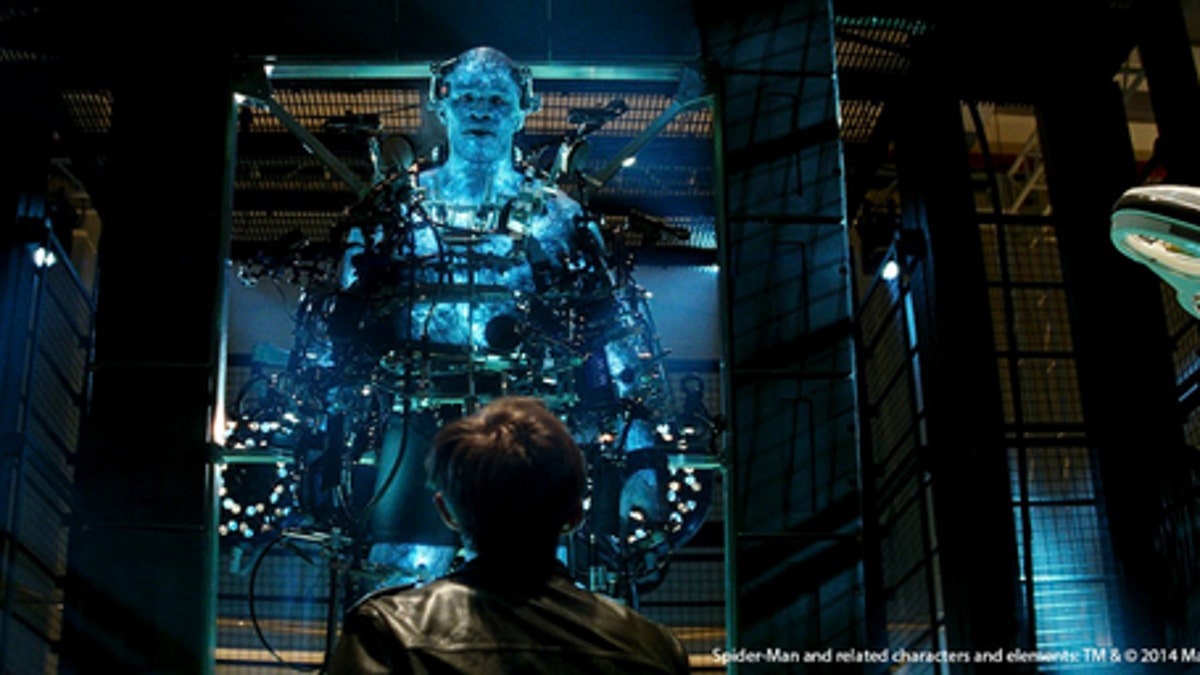
Exosuits abound in "Spider-Man 2," with both the Goblin and Rhino donning the robotic exoskeletons in the flick. Such evildoers use these highly engineered exosuits — similar to some actually in development in the United States — to become supe (TM & copyright 2014 Marvel. Copyright 2014 CTMG.)
The world of "The Amazing Spider-Man 2" is larger than life, and it contains some serious web-slinging scientific action.
From modern laboratories to genetic engineering, the new "Spider-Man" movie is packed full of extreme, cutting edge and mostly fictional science. The newest sequel in the comic book franchise, due for release nationwide on May 2, may not be very realistic, but it does draw on some real-life science that researchers use today.
"Science and technology in this universe is the same kind of thing that magic does in 'Harry Potter,'" Marc Webb, the director of the film, said during a press event here in Manhattan on April 27. "It's what allows you to access the subconscious. It's a little bit absurd, and it's a little bit surreal, but it's not meant to be realistic. It's meant as a way to crack the world open and reveal parts of ourselves and the surreal, mystical parts of storytelling that you need to access."
Here are four things every science geek should look out for in "The Amazing Spider-Man 2": (Warning: This story does not contain spoilers, but some aspects of the film's plot are discussed.)
Laboratories
The copious numbers of laboratories shown in "The Amazing Spider-Man 2" are actually pretty scientifically sound. Webb knows a thing or two about real-life laboratories.
"We looked a lot at real laboratories," the director told Live Science during the press event. "My mom worked in a lab for her entire career. I grew up in Wisconsin next to a university my brother is an engineer. I spent so much of my life and lunchtimes sitting while my mom was drawing blood So yeah, there's always some foundation in reality."
One of the laboratories in the film got the stamp of approval from a real-life scientist who works in Paris, said Matthew Tolmach, one of the producers of the new movie. According to Tolmach, the scientist said: "I have to tell you, you guys nailed the look of the lab so specifically."
[Photos: The World's 5 Most Extreme Laboratories]
"She was blown away by the authenticity of all the stuff in Richard Parker's lab in the opening," Tolmach said.
Exosuits
Special suits abound in "Spider-Man." Evildoers use highly engineered exosuits similar to some actually in development in the United States to become superhuman. Harry Osborn, the son of Norman Osborn, who founded Oscorp, dons his own suit to become the Green Goblin.
Wearing the exosuit during the battle between Spider-Man and the Green Goblin was physically challenging for actor Dane DeHaan.
"That set was 110 degrees Fahrenheit [43 degrees Celsius] at least, and I was wearing a 50-lb [23 kilograms] suit," DeHaan said during the press event. "They were literally pouring buckets of ice water down my suit in between takes, and it was turning to steam before we started again. That was physically challenging."
The Rhino, another villain in the movie, gets his name from the shape of the exosuit he wears. A few other exosuits, like Doctor Octopus's arms, appear in the background of scenes at Oscorp.
Genetic mutations
It wouldn't be Spider-Man without a little genetic mutation; after all, Peter Parker himself was bitten by a mutated spider, which gave him super powers. In the movie franchise, other people including Harry Osborn covet Spider-Man's blood for its potentially healing properties.
Oscorp Industries, the fictional company that's the root of evil in this Spider-Man story, is a genetics laboratory where scientists work on experimental, cutting-edge research. Scientists at Oscorp have tried to combine human DNA with other animals in order to genetically engineer super hybrids.
While animal-human hybrids are largely considered the stuff of legend, real-life scientists have grown cartilage in the shape of a human ear on the back of a mouse. And other animals, like a lion and tiger, can interbreed, creating hybrids.
Max Dillon (played by Jamie Foxx in the new movie) worked at Oscorp until an accident at the plant turned him into the villain Electro. After the accident, Dillon mutated, becoming a powerful villain with electricity instead of blood running through his veins.
Electricity
While the Electro storyline is a little ridiculous, "The Amazing Spider-Man 2" actually bases some of its major plot elements on the way electricity and the grid system that powers cities in the United States behaves.
Without giving too much of the plot away, Electro goes after the grid system he helped build in New York, causing a blackout for the major city. Some studies have shown that these kinds of widespread, extreme blackouts could occur if a severe solar storm hit Earth, overloading the grid system and causing difficult-to-repair damage.
